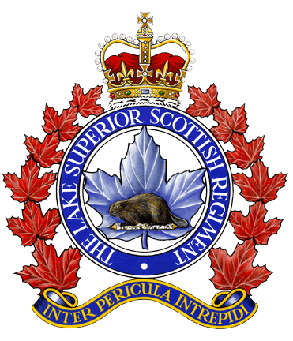Related Research Articles

The 20th Battalion, CEF was a unit of the First World War Canadian Expeditionary Force.
The Peel and Dufferin Regiment was an infantry regiment of the Non-Permanent Active Militia of the Canadian Militia. First organized in 1866 as the 36th Peel Battalion of Infantry, the regiment was reorganized in 1900 as the 36th Peel Regiment. Following the First World War, the regiment was reorganized again in 1920 as The Peel Regiment and for the final time in 1923 as The Peel and Dufferin Regiment. In 1936, the regiment was Amalgamated with The Lorne Rifles (Scottish) to form The Lorne Scots.
The Highland Light Infantry of Canada was an infantry regiment of the Canadian Army. In 1965, the regiment was amalgamated with The Scots Fusiliers of Canada to form The Highland Fusiliers of Canada.

The Lake Superior Scottish Regiment is a Primary Reserve infantry regiment of the Canadian Forces. The regiment is located in Thunder Bay, Ontario, and is part of the 3rd Canadian Division's 38 Canadian Brigade Group. Also known as "The Lake Sups" (pronounced soups), the regiment was active during the First and Second World Wars. During the latter, the regiment, then known as The Lake Superior Regiment or LSR, mobilized a motorized infantry battalion for the 4th Canadian (Armoured) Division; The Lake Superior Regiment (Motor) or LSR(M).

The 5th Battalion, CEF, known as "Tuxford's Dandys," was an infantry battalion of the Canadian Expeditionary Force during the Great War.
The 9th Battalion, CEF, an infantry battalion of the Canadian Expeditionary Force, was authorized on 10 August 1914. It embarked for Britain on 1 October 1914, where it was redesignated as the 9th Reserve Infantry Battalion, CEF, on 29 April 1915, to provide reinforcements for the Canadian Corps in the field. The battalion was formally disbanded on 15 September 1917.
The 116th Independent Field Battery, Royal Canadian Artillery is a Canadian Army Reserve independent artillery battery based in Kenora, Ontario, which forms part of the 3rd Canadian Division's 38 Canadian Brigade Group. The battery parades at the Kenora Armoury, 800-11th Avenue North.

The 8th Battalion, CEF, also known by the nickname of The Little Black Devils of Canada, was an infantry battalion of the Canadian Expeditionary Force during the Great War. The battalion was authorized on 10 August 1914 and embarked for Great Britain on 1 October 1914. It disembarked in France on 13 February 1915, where it fought as part of the 2nd Canadian Brigade, 1st Canadian Division in France and Flanders until the end of the war. The battalion was disbanded on 15 September 1920.

The 44th Battalion (Manitoba), CEF, was an infantry battalion of the Canadian Expeditionary Force during World War I.

The 46th Battalion, CEF, was an infantry battalion of the Canadian Expeditionary Force during the Great War.

The 52nd Battalion, CEF, was an infantry battalion of the Canadian Expeditionary Force during the Great War.

The 94th Battalion, CEF, was an infantry battalion of the Great War Canadian Expeditionary Force. The 94th Battalion was authorized on 22 December 1915 and embarked for Britain on 28 June 1916, where, on 18 July 1916, its personnel were absorbed by the 17th Reserve Battalion, CEF and the 32nd Battalion, CEF, to provide reinforcements for the Canadian Corps in the field. The battalion disbanded on 27 July 1918.
The 42nd Field Artillery Regiment, RCA is a Canadian Army Reserve artillery regiment based in Pembroke, Ontario. It is part of the 4th Canadian Division's 33 Canadian Brigade Group.
The Lorne Rifles (Scottish) was an infantry regiment of the Non-Permanent Active Militia of the Canadian Militia (now the Canadian Army). First raised in the 1860s, the regiment was known for most of its existence as The Halton Rifles until 1931 when the regiment was renamed as The Lorne Rifles (Scottish). In 1936, the regiment was amalgamated with The Peel and Dufferin Regiment to form The Lorne Scots (Peel, Dufferin and Halton Regiment).
The Victoria and Haliburton Regiment was an infantry regiment of the Non-Permanent Active Militia of the Canadian Militia. In 1936, the regiment was converted from infantry to artillery to become the 45th Field Battery RCA and now forms part of the 50th Field Artillery Regiment, RCA.
The Peterborough Rangers was an infantry regiment of the Non-Permanent Active Militia of the Canadian Militia. In 1936, the regiment was amalgamated with the 3rd Prince of Wales' Canadian Dragoons to form The Prince of Wales Rangers.
The Dufferin Rifles of Canada was an infantry regiment of the Canadian Non-Permanent Active Militia 1866-1936.
The York Rangers was an infantry regiment of the Non-Permanent Active Militia [NPAM] of the Canadian Militia. Although the unit was first officially created in 1866, the regiment traces its ancestry and origins as far back to Rogers' Rangers of the Seven Years' War, the Queen's Rangers of the American Revolutionary War and also the York Militia of the War of 1812. In 1936, the regiment was amalgamated with The Queen's Rangers to form The Queen's York Rangers.
The Argyll Light Infantry was an infantry regiment of the Non-Permanent Active Militia of the Canadian Militia. In 1936, the regiment was converted from infantry to form one of the Canadian Army's first tank units, and then in 1946 was converted to anti-tank artillery. In 1954, the regiment was converted back to infantry and amalgamated along with The Midland Regiment into The Hastings and Prince Edward Regiment.
The Grey Regiment was an infantry regiment of the Non-Permanent Active Militia of the Canadian Militia. In 1936, the regiment was amalgamated with the Simcoe Foresters to form the Grey and Simcoe Foresters.
References
- ↑ "Officers' Declaration Paper - D.C. McKenzie". Archives Canada. Retrieved 19 April 2022.
- ↑ Appendix to General Order No. 123 of 1929
- ↑ "116th Independent Field Battery, RCA". www.canada.ca. 2019-01-28. Retrieved 2022-08-28.
- ↑ "The Lake Superior Scottish Regiment". www.canada.ca. 2018-10-26. Retrieved 2022-08-15.
- Meek, John F. Over the Top! The Canadian Infantry in the First World War. Orangeville, Ont.: The Author, 1971.